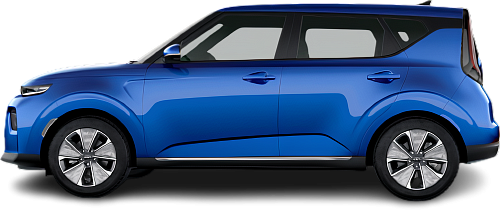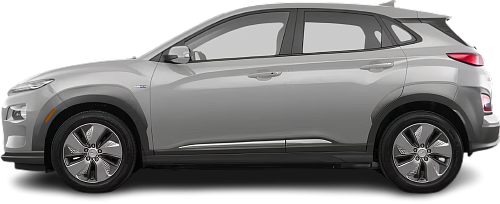Global EV Comparison: Kia Soul EV Standard Range vs Hyundai Kona Electric Standard Range
Struggling to Decide? Let AI Help!
Your AI Summary Is Ready!
General Info
The Kia Soul EV Standard Range (2020-…) is currently produced, it has a starting price of €38418. The Hyundai Kona Electric Standard Range (2019-2021) has been discontinued. You can find it for as low as €16990 on the used car market.
The two vehicles share the same body style: SUV.
| Property | Kia Soul EV Standard Range | Hyundai Kona Electric Standard Range |
|---|---|---|
| Years of Production | 2020-… | 2019-2021 |
| Current Status | Produced | Discontinued |
| Country of Manufacture | South Korea | Czech Republic, India, South Korea |
| Body Style | SUV | SUV |
| Market Availability | EU | EU |
| Price Europe (New) | €38418 | - Price Europe (New) |
| Price Europe (Used) | €15999 | €16990 |
| GCC Score | 5.1 | 5.2 |
Range and Efficiency
Although both cars have the same battery capacity, Hyundai Kona Electric Standard Range (2019-2021) achieves a longer real-world range due to its superior energy efficiency.
| Property | Kia Soul EV Standard Range | Hyundai Kona Electric Standard Range |
|---|---|---|
| Range (WLTP) | 276 km | 305 km |
| Range (GCC) | 235 km | 259 km |
| Battery Capacity (Nominal) | 42 kWh | 42 kWh |
| Battery Capacity (Usable) | 39.2 kWh | 39.2 kWh |
| Efficiency per 100 km | 16.7 kWh/100 km | 15.1 kWh/100 km |
| Efficiency per kWh | 5.99 km/kWh | 6.61 km/kWh |
| Range and Efficiency Score | 5.4 | 6.1 |
Charging
Both vehicles utilize a standard 400-volt architecture.
Both vehicles support DC fast charging with a maximum power of 44 kW.
Both vehicles are equipped with the same on-board charger, supporting a maximum AC charging power of 7.2 kW.
| Property | Kia Soul EV Standard Range | Hyundai Kona Electric Standard Range |
|---|---|---|
| Max Charging Power (AC) | 7.2 kW | 7.2 kW |
| Max Charging Power (DC) | 44 kW | 44 kW |
| Architecture | 400 V | 400 V |
| Charge Port | CCS Type 2 | CCS Type 2 |
| Charging Score | 4 | 4 |
Performance
Both vehicles are front-wheel drive.
With equal motor power, both cars deliver the same 0-100 km/h acceleration time.
| Property | Kia Soul EV Standard Range | Hyundai Kona Electric Standard Range |
|---|---|---|
| Drive Type | FWD | FWD |
| Motor Type | PMSM | PMSM |
| Motor Power (kW) | 100 kW | 100 kW |
| Motor Power (hp) | 134 hp | 134 hp |
| Motor Torque | 395 Nm | 395 Nm |
| 0-100 km/h | 9.9 s | 9.9 s |
| Top Speed | 157 km/h | 155 km/h |
| Performance Score | 3.1 | 3.1 |
Dimensions
The Kia Soul EV Standard Range (2020-…) is taller, but has a similar length and width to the Hyundai Kona Electric Standard Range (2019-2021).
Both models have similar wheelbase lengths.
| Property | Kia Soul EV Standard Range | Hyundai Kona Electric Standard Range |
|---|---|---|
| Length | 4195 mm | 4180 mm |
| Width (with Mirrors) | - Width (with Mirrors) | 2070 mm |
| Width (w/o Mirrors) | 1800 mm | 1800 mm |
| Height | 1605 mm | 1570 mm |
| Wheelbase | 2600 mm | 2600 mm |
Cargo and Towing
The Hyundai Kona Electric Standard Range (2019-2021) features a larger trunk, but the Kia Soul EV Standard Range (2020-…) offers greater maximum cargo capacity when the rear seats are folded.
Neither car is equipped with a frunk (front trunk).
Neither vehicle is officially rated for towing in in the EU.
| Property | Kia Soul EV Standard Range | Hyundai Kona Electric Standard Range |
|---|---|---|
| Number of Seats | 5 | 5 |
| Curb Weight | 1610 kg | 1610 kg |
| Cargo Volume (Trunk) | 315 l | 332 l |
| Cargo Volume (Max) | 1339 l | 1114 l |
| Cargo Volume (Frunk) | - Cargo Volume (Frunk) | - Cargo Volume (Frunk) |
| Towing Capacity | - Towing Capacity | - Towing Capacity |
| Cargo and Towing Score | 5.5 | 5.3 |




